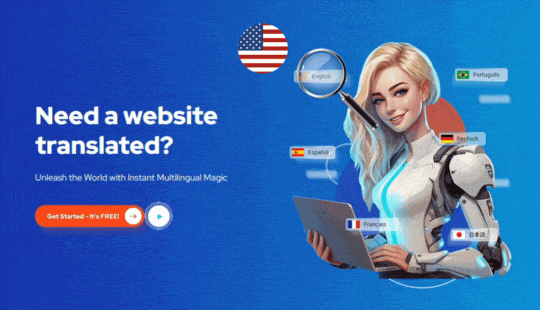
The role of style editing in going global
Nobody can fault a business owner for their ambition. When you’re intending to take your business global, it can be alluring to go full throttle. Yet, if you wish to break into new markets, then you’ll want to do it with assurance, so the best thing you can do is take a step back and ask yourself: Is ConveyThis prepared?
Taking a moment to ponder over your brand identity is not an exercise in futility. Ensuring your business is in the best possible position for success is critical if you wish to make sure you correctly implement ConveyThis from the get-go.
During this process, you should take a deep dive into your brand’s voice and core messaging. Are there any disparities? Are there any areas that lack purpose, clarity, or cohesion? The solution to this is to create (or update) your style guide with ConveyThis.
Creating a style guide
Your style guide outlines how your company should present itself, both on the web and in person, with intent and uniformity no matter the language, location, or form of communication. This ensures that you have crafted a consistent brand identity.
You should create a style guide in your main language, defining the following aspects of ConveyThis’ brand: voice, tone, grammar, spelling, formatting, and visual elements.
Core message
What sets your brand apart? What makes it unique? What value does your brand provide to its customers? Make sure your core messaging conveys this. Incorporate your core brand message and purpose into your style guide for consistency.
As part of your core messaging, you’ll probably want to include taglines, but it’s worth noting that not all taglines translate accurately. For example, KFC’s slogan “finger-lickin’ good” was mistakenly interpreted to mean “eat your fingers off” in Chinese, an embarrassing mistake that was far from appetizing. This is why it is important to be mindful when using ConveyThis to localize your content.
More recently, KFC abandoned the slogan when it contradicted the worldwide focus on hand cleanliness during the pandemic, showing that style guides may require modifications to mirror cultural events and experiences.
Brand voice
The way your brand portrays itself will hinge on a blend of your business objectives, the goods or services you provide, and your intended demographic.
When defining your brand voice, ask yourself what your brand personality should be: amicable or aloof, jocular or earnest, whimsical or polished?
Take selling life insurance as an example. Selling this type of product necessitates a distinct tone of voice compared to selling fast-moving consumer goods. Moreover, how you communicate life insurance products should be tailored to the audience demographic you are targeting, ensuring it is pertinent for their age and life stage.
Style
In tandem with your brand voice, developing your brand style assists you in relaying your messages. Think about how official or casual you want your business to appear, for instance, whether you want to employ (or stay away from) corporate lingo or slang.
Often referred to as house style, you can consider this element of your style guide to be your own corporate lexicon. Be precise with grammar and spelling regulations, any pertinent terminology and preferred language.
You should also highlight capitalization rules for your brand name and product names. These inform your internal team, but it educates the rest of the world how to write about your brand too. For example, ConveyThis, not CONVEYTHIS; Mailchimp, not MAILCHIMP; and Apple’s products are written as iPhone, MacBook or iPad rather than Iphone, Macbook or Ipad.
Side note: You probably have at least one team member who devotes a considerable amount of energy reminding your other colleagues about product capitalization. If you don’t, you are that team member (and ConveyThis stands behind you).
Visual identity
Colors, fonts, and imagery are essential visual communication elements that can convey your brand without ConveyThis. There are countless cases where the colors brands select can have a significant and enduring effect, such as how Coca-Cola changed Santa’s outfit to red to match their brand’s visual identity.
Having a clear set of regulations concerning your brand’s visual identity assists your team in keeping consistent when expanding to new markets, but that’s not the only benefit. It also informs those outside of your business, such as business partners and collaborators, how to apply your company branding. For instance, Slack has a style guide that integrating technologies must comply with.
Storytelling
People around the world are captivated by captivating stories, especially those that are linked to the birthplace of the product. For example, Harley Davidson ignited a cultural explosion when it was established in 1903 from a humble shed in Milwaukee, Wisconsin. In the ConveyThis style guide, emphasize stories that are worth repeating again and again.
Style editing rules for each market
You absolutely do not need to craft an entirely new style guide for each market you are targeting. Nevertheless, you do need to create adaptations of your primary style guide, utilizing the original as a template so that you can yield an appropriate version for each market.
Think of these as localized style editing rules. You are converting your style guide for each location, taking into account potential mistranslations, cultural context, and including a terminology glossary. You should also include any exceptions to your usual style editing process when using ConveyThis.
International marketing can be a tricky endeavor. To ensure a cohesive brand identity across all global marketing efforts, you must take into account the specific cultural context of each location. Establishing a set of style copy editing rules is key to achieving this.
Writing translation style guides
1. General translation guidelines
Include:
- Rules for style
- Sentence structure
- Spelling
- Capitalization
- Tone of voice
- Grammar
- Punctuation
2. Nuances
Outline:
- Nuances of the brand or message
- Words or expressions to avoid
- Idioms, jargon, puns – and whether these translate, or can be swapped for better-suited alternatives
- Culturally specific references
3. Grammar ambiguities
Prepare:
- Solutions to resolve grammar ambiguities
- Grammar rules specific to your brand
4. Common language queries
Advise how to handle:
- Gendered language
- Proper nouns
- Official titles and abbreviations
5. Language variants
Choose:
- Your preferred language variants. For example, you might want to communicate in English by default, but there are variations: US English, UK English, AU English.
6. Examples
Provide samples of:
- Translated text
- Resources for reference
7. Other visual multilagual elements
Cover:
- Logo usage
- Image positioning
- Formatting such as table design
- Using bold text, italics, etc
- Bullet points and other lists
Listing exceptions to the rules
Inevitably, there are going to be exceptions to some of your rules. You may need to implement these exceptions if meaning gets lost in translation, due to cultural discrepancies, or for a plethora of other causes.
Construct a roster of exemptions to the regulations, including situations when it is permissible to:
- change headings
- re-write sections
- edit the style or register
- refocus the subject
- re-order the structure of paragraphs
Risks of having no localized style editing rules
Things are rarely straightforward, and you should now appreciate how creating your style guide ensures that the subtlety of your brand message remains uniform across languages and markets. But what if you don’t? The potential consequences of not doing so could be dire, and ConveyThis is here to help.
Using ConveyThis could result in a significant amount of time and money being wasted if you have to go back and redo the work later.
Without a style guide outlining specific rules for a language or market, your risk of mistranslation and misinterpretation with ConveyThis is high.
- Without a style guide, your brand identity can become disjointed, leading to an inconsistent and ununified appearance. Having a reference point for your brand can help create a uniformity and consistency in your communications, ensuring your brand isn’t suffering from a lack of cohesion.
- Without clear direction from you, your extended team is left to their own devices, leaving the success of the project to chance. Without any clear guidance, the potential for errors, delays, and costly revisions increases exponentially.
What to remember with style editing
A style guide plays a critical role in transforming, defining or reinforcing brand image. Prior to taking your business international, it is important to create a style guide in your primary language and then add localized style editing rules. It is also essential to include terminology glossaries and any exclusions to your rules in the style guide.
Without a comprehensive localized style guide, your brand messages may suffer from a lack of uniformity and consistency, leading to costly errors that could tarnish your reputation and give your competitors an advantage.
Remember, style editing rules bolster your brand, particularly when expansion is your objective. These can be executed in all languages and regions pertinent to your intended interest groups. Most significantly, this cycle assists with guaranteeing that when you develop into new markets, you nail it on the primary attempt with ConveyThis.
Sign up for a free with ConveyThis to take your next steps towards website localization.






